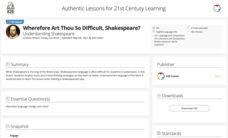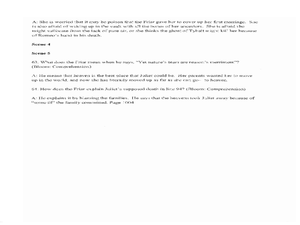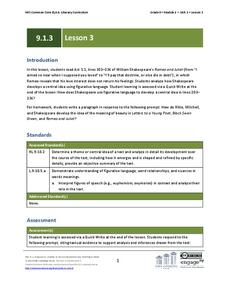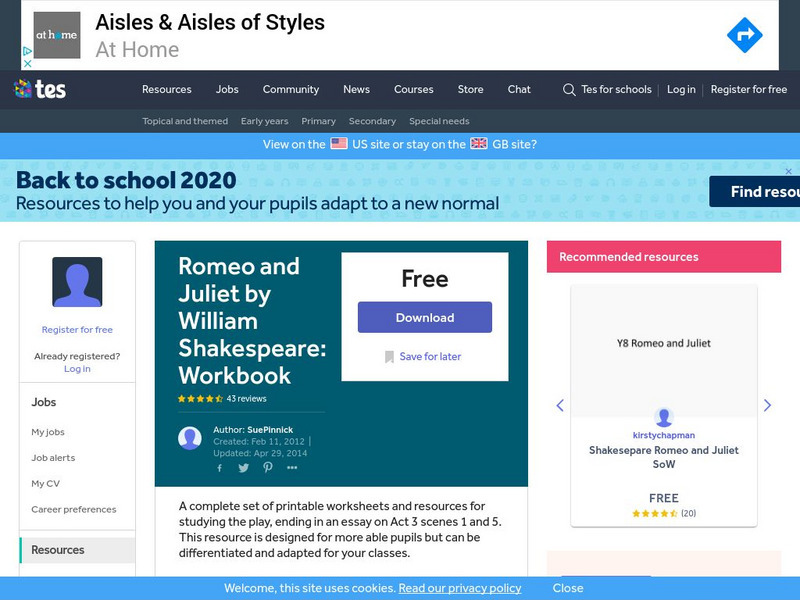K20 LEARN
My Love Is Like Figurative Language: Figurative Language in Romeo and Juliet
My love is like an anaconda. Huh? Scholars investigate similes, metaphors, hyperbole, and personification used by writers to express feelings. They examine lyrics from songs and lines from Romeo and Juliet and consider how the use of...
Curated OER
Figurative Language in Romeo and Juliet
Shakespeare was such a talented writer, but why? It must be his use of figurative language, blended with his clever, twisting plots. This worksheet focuses on his use of metaphor, simile, personification, oxymoron, and hyperbole within...
Montgomery Public Schools
Romeo and Juliet Study Packet
William Shakespeare's Romeo and Juliet, a play about star-crossed lovers, resonates deeply with teenagers. The study packet contains study questions for each act of the play. Learners use a graphic organizer to analyze whether characters...
Curated OER
Romeo & Juliet (Drama)
Ninth graders read and internalize the drama Romeo and Juliet by William Shakespeare. Many intriguing and thought provoking assignments are waiting for the completion of students within this lesson profile.
K20 LEARN
Wherefore Art Thou So Difficult, Shakespeare? Understanding Shakespeare
'Tis not easy to understand the language of the Bard! But, hark! Fret not! With the assistance of this joyous lesson, young players learn how to translate Shakespeare's English into modern language. Groups examine passages from Julius...
Curated OER
Boys Will Be Boys...Right?
Through this exercise, high schoolers identify character traits present in Romeo and Juliet. They listen to an excerpt from "The Office of Christian Parents: Showing How Children Are to be Governed" and participate in a Socratic...
EngageNY
Grade 9 ELA Module 1: Unit 3, Lesson 5
Class members continue their study of Romeo and Juliet by watching scenes from Baz Luhrmann’s Romeo + Juliet and then examining the figurative language Shakespeare uses in Act 1, scene 5, lines 92–109 when Romeo and Juliet meet at the ball.
Curated OER
Figurative and literal language through the study of Shakespeare
Sixth graders explore figurative and literal language. They study literary devices through short pieces of Shakespeare's work. Then investigate Shakespeare's works and life.
EngageNY
Grade 9 ELA Module 1: Unit 3, Lesson 3
Class members listen to a masterful reading of Act 1, Scene 1, lines 203-236 of Romeo and Juliet and then break into groups to examine how Shakespeare uses figurative language to develop Romeo's idealized concept of beauty.
Curated OER
A New Look at Romeo and Juliet
Students explore life and language development in the Elizabethan Age. In this English instructional activity students complete web-quests and other activities surrounding Shakespeare's Romeo and Juliet.
Curated OER
Seventeenth Century Pick-up Lines
Students analyze passages from The Mysteries of Love and Eloquence, or the Arts of Wooing and Complementing, written in the seventeenth century. Students analyze the images, words and figures of speech the author used and compare the...
Southern Nevada Regional Professional Development Program
Reading Literature - Romeo and Juliet
“What is the theme of this story?” Now there’s a question all pupils dread. Rather than encountering a sea of faces that look like they were painted by Edward Munch, face a classroom filled with smiles and confidence. Show your readers...
Curated OER
You Kiss the Book: Shakespeare's Romeo and Juliet
Learners analyze imagery in Shakespeare's, Romeo and Juliet, and act out the passage to see how the author includes stage directions with his poetry.
Curated OER
Figurative Language Alive: Balcony Scene Charades
Young scholars act out lines from Romeo and Juliet in a charade-like game.
Curated OER
Original Line or Familiar Find?
Young scholars examine a primary source document from 1684 that includes many of the same lines found in Romeo's speech to Juliet from Shakespeare's Romeo and Juliet. Students compare the texts and discuss authorship during the sixteenth...
Curated OER
Irony in "The Gift of the Magi"
Use O. Henry's ubiquitous tale of love and poverty to explore irony. After reading the story, middle schoolers identify examples of all three kinds of irony in the story. With partners, they brainstorm original examples of irony. Then...
Curated OER
Playing with Shakespeare's Language
Students can understand Shakespeare's language using comprehensible input and dramatic play.
Think Map
Shakespearean Idioms
How do you react if you're "hot-blooded?" What happens when you engage in a "wild goose chase?" And what are "salad days?" Use this worksheet and the online Visual Thesaurus to answer these questions and more. Based on...
TES Global
Tes: Romeo and Juliet by William Shakespeare: Workbook
[Free Registration/Login Required] This is a 30-page study guide for the play Romeo and Juliet by William Shakespeare including "The Prologue" and excerpts from the text with questions, research on the context of the play, figurative...
TES Global
Tes: Romeo & Juliet: Parent & Child Relationships
[Free Registration/Login Required] This extensive lesson focuses on the parent/child relationships in Romeo and Juliet and in Ben Jonson's poem "On My First Sonne." Several activities are provided to aid students in comparing the...
CommonLit
Common Lit: Excerpts From "Romeo and Juliet" by William Shakespeare
A learning module that begins with "Excerpts from Romeo and Juliet" by William Shakespeare, accompanied by guided reading questions, assessment questions, and discussion questions. The text can be printed as a PDF or assigned online...
Louisiana Department of Education
Louisiana Doe: Louisiana Believes: English Language Arts: Grade 9: Romeo and Juliet
Young scholars explore how patterns and contrasts in language (diction, imagery, figurative language) reveal central ideas in texts and develop various motifs (light vs. dark, dreams vs. reality, high vs. low, etc.) in Romeo and Juliet....




















